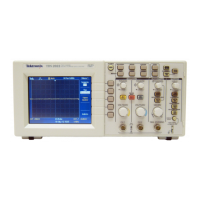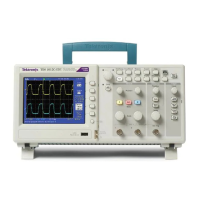Command Syntax
TDS200/1000/2000 Series Oscilloscope Programmer Manual
2−7
H When you concatenate queries, the responses to all queries are
combined into a single response message. For example, if
channel 1 coupling is set to DC and the bandwidth is set to
20 MHz, the concatenated query:
CH1:COUPling?;BANdwidth?
returns :CH1:COUPLING DC;:CH1:BANDWIDTH ON if header is on,
or DC;ON if header is off.
H You can concatenate set commands and queries in the same
message. For example:
ACQuire:MODe AVErage;NUMAVg?;STATE?
is a valid message that sets the acquisition mode to normal,
queries the number of acquisitions for averaging, and then
queries the acquisition state. The oscilloscope executes
concatenated commands and queries in the order it receives
them.
H Any query that returns arbitrary data, such as ID?, must be the
last query when part of a concatenated command. If the query is
not last, the oscilloscope generates event message 440.
Here are some INVALID concatenation examples:
H CH1:COUPling DC;ACQuire:NUMAVg 16
(missing colon before ACQuire)
H CH1:COUPling DC;:BANDwidth ON
(invalid colon before BANDwidth)
H CH1:COUPling DC;:*TRG
(invalid colon before a star (*) command)
H HORizontal:MAIn:POSition 0;MAIn:SCAle 1E–13
(levels of mnemonics are different—either remove the second
occurrence of MAIn:, or put :HORizontal: in front of
MAIN:SCAle)

